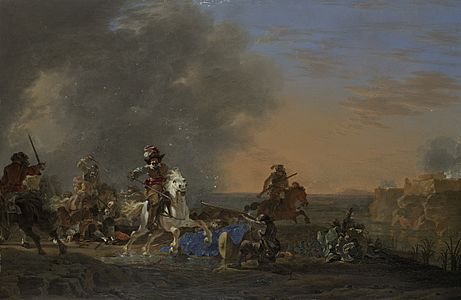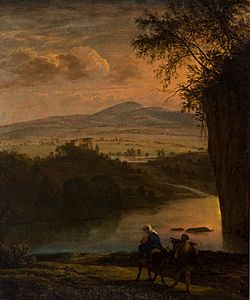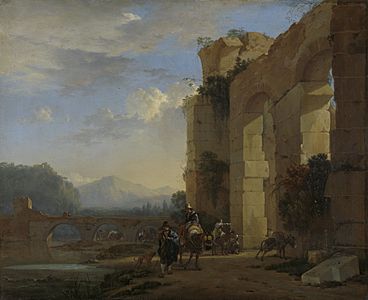Jan Asselijn facts for kids
Quick facts for kids
Jan Asselijn
|
|
|---|---|

Portrait of Jan Asselijn by Rembrandt, 1647
|
|
| Born | c. 1610 |
| Died | c. 1652 |
| Nationality | Dutch |
| Known for | Painting |
Jan Asselijn (born around 1610 – died October 1, 1652) was a famous Dutch Golden Age painter. He was known for his beautiful landscapes and paintings of animals.
Contents
Life of Jan Asselijn
Jan Asselijn was born in Dieppe, France. His family were Huguenots, which means they were French Protestants. Jan learned to paint from Esaias van de Velde, a well-known artist.
Traveling and Painting
Jan Asselijn became very good at painting landscapes and animals. People also admired his paintings of historical events and battles. He traveled a lot, visiting France and Italy. In Italy, he learned from other artists like Bamboccio (Pieter van Laer).
While in Italy, Jan joined a group of Dutch and Flemish artists called the Bentvueghels. This group lived and worked in Rome. They gave each other fun nicknames. Jan Asselijn had a withered hand and was small, so they called him Krabbetje, which means "little claw." In France, people called him petit Jean Hollandois, or "little John the Dutchman."
Friendship with Rembrandt
Jan Asselijn was friends with the famous painter Rembrandt. Rembrandt even made an etching of Jan. In some versions of this etching, Jan appears to be standing in front of an easel, ready to paint.
New Painting Style
Jan Asselijn was one of the first Dutch painters to use a fresh and clear style for landscapes. His paintings were similar to those of Claude Lorraine, another famous artist. Many other painters soon followed Jan's example. His artwork was very popular in Amsterdam, and you can still see many of his paintings in museums there today.
Famous Artwork
One of Jan Asselijn's most famous paintings is called The Threatened Swan. This painting shows a swan bravely protecting its nest from a dog.
The Threatened Swan
The Threatened Swan became a symbol of Dutch national resistance. This means it represented the Dutch people fighting to protect their country. We don't know if Jan Asselijn meant for it to be a symbol when he painted it.
Later, people added words to the painting. For example, "Holland" was written on one of the eggs, and "Enemy of the state" was written next to the dog. Some people thought the swan represented Johan de Witt, an important Dutch leader. The painting was made in the 1640s and is now a major artwork at the Rijksmuseum. It was the very first painting the Rijksmuseum bought!
Other Works
For a long time, a painting called City Wall in the Winter was thought to be by Jan Asselijn. However, when the painting was cleaned, the real artist's signature was found. It turned out to be by Willem Schellinks.
Gallery
-
St. Anthonisdijk or St. Anthony's dyke breach at Houtewael burst in the night of 5–6 March 1651
See also
 In Spanish: Jan Asselijn para niños
In Spanish: Jan Asselijn para niños






